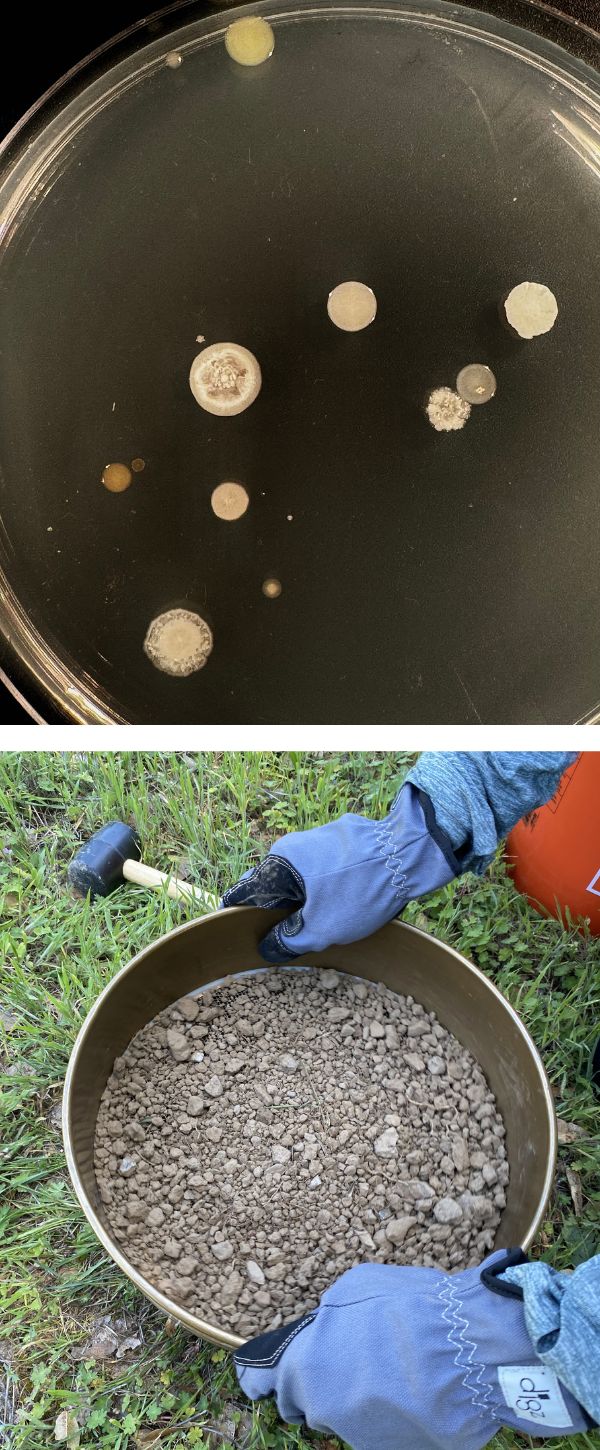Many people think of soil as simply dirt, but in fact, it is teeming with life. Inside just a handful of soil are billions of microbial organisms that live together as communities, sharing and competing for resources. Together, these communities impact the planet in astonishing ways, for example, by sequestering carbon from the atmosphere.

Top: Colonies of soil bacteria are seen on a petri plate. Bottom: A bucket of soil collected at the Hopland Research & Extension Center in Mendocino County. Photos by Zoila Alvarez-Aponte.
Despite the critical roles these communities play in the health of our environment, their size and complexity make it difficult to understand how each microbe contributes to ecosystem-level processes. To address this challenge, researchers in the lab of Michi Taga, a professor in the Department of Plant and Microbial Biology, developed a model that allows them to dissect how one nutrient impacts microbial communities across scales—from the individual microbe to the ecosystem level—by influencing intermicrobial interactions.
This approach was named the “corrinoid model” by Taga because it focuses on the corrinoid family of nutrients related to vitamin B12. She served as the corresponding author for two papers in The International Society for Microbial Ecology (ISME) Journal that outlined the lab’s research and applications of the corrinoid model to understand microbial interactions in a California grassland soil.
In one study led by Zoila Alvarez-Aponte, a PhD candidate in the Taga lab, researchers isolated bacteria from the soil and studied them in the laboratory, culturing more than 100 different bacterial species including 37 that they discovered for the first time. The authors characterized each species, testing whether the bacteria can produce corrinoids for themselves or depend on neighboring microbes to provide them. “We found that surprisingly, all the isolates either synthesize or prefer B12, in contrast to the dozen other corrinoids that have been discovered in many other environments,” said Alvarez-Aponte.
A second study focused on how corrinoids impact the soil environment. “Despite previous results suggesting that corrinoids are limiting nutrients in soil, our chemical prospecting demonstrates that there is actually a deep reservoir of vitamin B12 present in soils,” said postdoctoral researcher Zachary Hallberg, who co-led the study with Alexa Nicolas, PhD ’22 Microbiology. “When we added vitamin B12 to the soil, the composition of the bacterial community did not change, but the addition of alternate corrinoids caused distinct changes in the soil community,” notes Nicolas.
According to Taga, this discovery opens the exciting possibility of using corrinoids to alter microbial communities and elicit healthier environmental and human health outcomes. The lab will now explore how individual bacteria interact with each other to form complex communities that impact carbon sequestration, human and plant health, and remediation of toxic chemicals.
Read More
Phylogenetic distribution and experimental characterization of corrinoid production and dependence in soil bacterial isolates (ISME Journal)
Authors of this article include Zoila Alvarez-Aponte, Alekhya Govindaraju, Zachary Hallberg, Alexa Nicolas, Myka Green, Kenny Mok, and Michiko Taga from PMB; Citlali Fonseca-Garcia and Devin Coleman-Derr, PMB-affiliated researchers from the USDA Plant Gene Expression Center; and Lawrence Berkeley National Laboratory researchers Hans Carlson and Eoin Brodie, who is also an adjunct associate professor in the Department of Environmental Science, Policy and Management (ESPM).
This work was supported by the U.S. Department of Energy (DOE), Office of Biological and Environmental Research (BER), Genomic Sciences Program (GSP) Grant DE-SC0020155 (M.E.T.), National Institutes of Health (NIH) Grant 3R35GM139633-03S2 (M.E.T.), the GEM Foundation (Z.I.A.A.), the Kase-Tsujimoto Foundation (Z.I.A.A.), and the Sponsored Projects for Undergraduate Researchers program at UC Berkeley (M.A.G.). E.L.B. was supported in part by the DOE, BER, GSP LLNL ‘Microbes Persist’ Soil Microbiome Scientific Focus Area SCW1632.
Soil microbial community response to corrinoids is shaped by a natural reservoir of vitamin B12 (ISME Journal)
Authors of this article include PMB’s Zachary Hallberg, Alexa Nicolas, Zoila Alvarez-Aponte, Kenny Mok, and Michiko Taga; Ella Sieradzki, a former postdoctoral researcher in ESPM; Jennifer Pett-Ridge of Livermore Lab; ESPM Professor Jillian Banfield; Hans Carlson of Berkeley Lab; and ESPM Professor Emerita Mary Firestone.
This work was supported by the U.S. Department of Energy (DOE), Office of Science, Office of Biological and Environmental Research, Genomic Science Program under Award Number DE-SC0020155 to M.E.T., and National Institutes of Health award 5K99GM143653-02 to Z.F.H. Work conducted at Lawrence Livermore National Lab (LLNL), including soil microcosm incubations with H218O and the subsequent generation of genome-resolved metagenomes, was performed under the auspices of the DOE under Contract DE-AC52-07NA27344 with support provided by the DOE, Office of Biological and Environmental Research, Genomic Science Program LLNL ‘Microbes Persist’ Scientific Focus Area (award #SCW1632)
